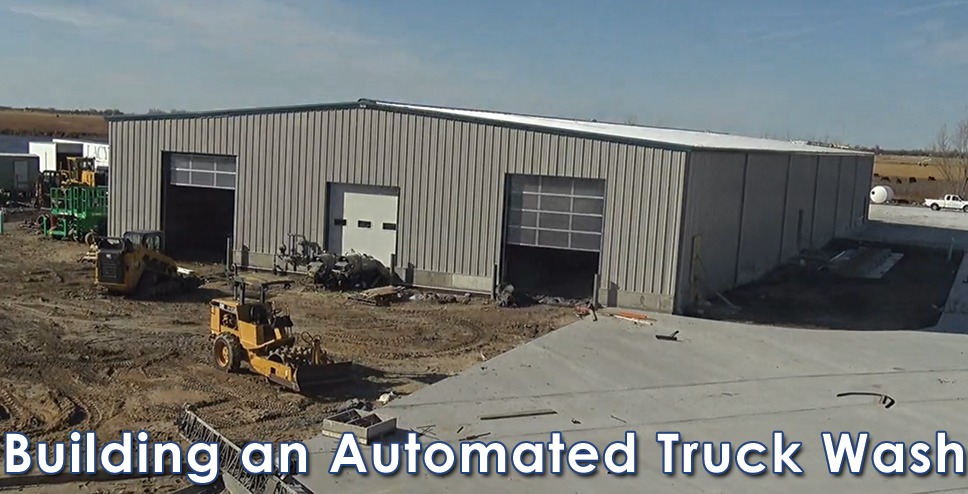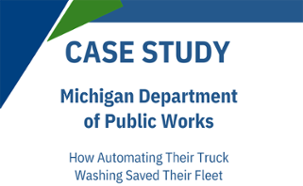If you're considering building an automated truck wash for your business, there's a lot of planning that needs to be done before you can start installing it.
A functional, efficient and safe automated system is more than just deciding what truck wash equipment you need.
But the more planning you do before installing it, the faster you can build your truck wash.
It begins with having a thorough understanding of your design space so that you can accurately evaluate potential solutions and make the right choice for your needs.
In this guide, we'll cover the key considerations and factors to keep in mind when designing and building an automatic wash; whether your fleet includes semi trucks, school buses, or heavy-duty equipment.
Why Design an Automated Truck Wash?
The single biggest benefit to having your automated truck wash is that you can clean your fleet at least nine times faster than doing it by hand.
What used to take you 45 minutes, depending on the size and shape of your rig, can be done in 3-5 minutes.
But when you have dozens of vehicles in your fleet, the advantages of an automated system expand beyond saving you hours of downtime.
You can schedule your fleet operation well in advance, and do it with more accuracy because you can predict how long one of your trucks will be sidelined.
An automated wash system also makes it easier to clean your undercarriage. This is can be very beneficial if you operate trucks in deep snow or heavy mud as it helps protect against rust, corrosion, and malfunctioning parts.
Finally, they require much less time and labor by the professional, which often ends up being your driver.
How Much Does it Cost to Build an Automated Truck Wash?
It's hard to estimate how much the total cost of your automated truck wash will be.
Beyond the price of the system itself, you have to factor in plumbing, electricity, and wash bay construction.
Even then, the size and shape of the system depend on the type of vehicle you want to clean.
But if you were just to purchase the system itself, the cost of your automated truck wash can drastically vary, from under $100,000 for just an undercarriage wash to over $400,000 for a system with all the bells & whistles.
Layout and Equipment Considerations
1. Get the Necessary Permission to Build
The specific permissions and permits that a business will need to build a new wash will depend on the location of the construction project and the type of business that is being established.
Here are some general steps that businesses may need to follow in order to obtain the necessary permissions and permits for new construction:
- Check local zoning laws: Before starting any construction project, you will need to make sure that the location where you plan to build is zoned for the type of construction you are planning. You may need to obtain a zoning permit or variance in order to build on the property.
- Obtain building permits: Depending on the nature and scope of your construction project, you may need to obtain one or more building permits from your local building department. These permits are typically required to ensure that the construction project meets local building codes and safety standards.
- Check any special needs permits: In addition to building permits, you may need to obtain special permits or approvals for certain types of construction projects. For example, you may need to obtain a permit to build on floodplains or wetlands or to build a structure that is larger than local zoning laws allow.
- Check for environmental permits: You may need to obtain environmental permits from state or federal agencies. These permits are typically required to ensure that the construction project does not harm the environment or natural resources.
2. Spec Out Your Wash Bay
The ideal wash bay size for a 2-step automatic system is 100 feet long and 20 feet wide. However, systems can be designed to fit in smaller wash bays. The ideal size for a standard 1-step wash bay is typically a minimum of 50-60 feet long.
We do suggest saving some additional room on the side for an equipment room to store the pumps and controls -- about 40ft by 12ft should be good enough.
3. Organize Your Truck Wash Utilities
If you’re thinking of building a truck wash facility, regardless of whether it is a drive-thru truck wash or a walk-in truck wash, you need to make sure you have easy access to water, electricity, and drainage.
You can use city water or well water for your truck wash, but your water source needs to be capable of handling at least 50 GPM at 50 PSI.
You'll also need a decent amount of electricity to power your truck wash. Any 3-phase power supply will do, but we recommend a 480V 3-phase power supply to run your rinse pumps at optimal performance.
With proper planning and sourcing, you’re able to produce a truck wash with high uptime and great labor retention.
4. Source Your Fleet Washing System
There are many different truck and fleet washing companies to source your equipment from, including Hydro-Chem Systems. But here is a quick cheat sheet to help you objectively choose the right partner for your business:
- Non-proprietary equipment: One of the easiest ways to ensure your system is always running is using non-proprietary wash equipment that will allow for more flexibility in maintenance.
- Quality of equipment: One of the most important factors to consider is the quality of the equipment offered by the manufacturer. Look for equipment that is durable, reliable, and easy to maintain. You should also consider whether the equipment meets industry standards and safety regulations.
- Price: Price is always a factor when choosing a fleet washing equipment manufacturer. When you get quotes from multiple manufacturers to compare prices, make sure to look closely at the equipment included to confirm you are comparing apples-to-apples and not getting a lesser system when you receive a lower price. (Pro tip: Ask your manufacturer when you can expect to see an ROI from your automatic wash system).
- Reputation: It is also important to choose a manufacturer with a good reputation in the industry. Look for a manufacturer that has a track record of producing high-quality equipment and providing excellent customer service by looking at review sites, and directories, or asking them for a reference.
- Customer service: Customer service is critical when it comes to fleet washing equipment. You want a manufacturer that is responsive, helpful, and easy to work with. Look for a manufacturer that offers training and support for their equipment, as well as a comprehensive warranty program.
- Flexibility: Finally, consider the flexibility of the manufacturer in terms of customization. Can the manufacturer accommodate your specific needs and requirements, and can they provide solutions that change with your business?
5. Select the Right Truck Wash Soaps & Detergents
This really depends on whether you want a brushless 2-step system, a 1-step with a brush, or a conventional touchless 1-step.
In a 2-step system, you coat your rig with a low pH acid pre-soak, then layer that with a high pH alkaline detergent to loosen dirt, grime, and road film so they can easily be removed with a quick rinse.
The reason why more and more organizations choose the 2-step system isn’t just because it’s faster, it’s because it won’t scratch or damage your paint.
There are many different low-pH and high-pH detergents, so make sure you get the best truck wash soap combination that meets your needs.
6. Plan Your Truck Wash Maintenance Schedule
The final step in planning out your truck wash is making sure you have a regular automated truck wash maintenance schedule.
We recommend that your fleet is cleaned regularly. This typically includes washing each unit every week or two.
Similarly, if you aren’t maintaining your automated wash system, it can slowly deteriorate over time — and the cost of repairing it will increase.
Here are the two key inspections you need to schedule:
- Drive-thru maintenance inspections: checking nozzles, spray patterns, water leaks, and the overall performance of your equipment.
- Walk-thru inspections: checking your soap dilution ratios, air pressure, and other individual parts of your system.
Building Your Automated Truck Wash
Now that you have a comprehensive plan, it’s time to build your automated truck wash.
- Make sure you have the right permits and permissions
- Design your washbay size
- Make sure you have the necessary utilities to run the system
- Find the right fleet wash equipment partner
- Choose the best truck wash soap for your needs
- Make sure you properly maintain your system
Once you do these six things, not only does it help you mitigate any potential mistakes or delays, but it also sets you up to see the return on your investment quicker.




